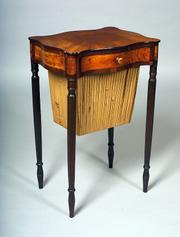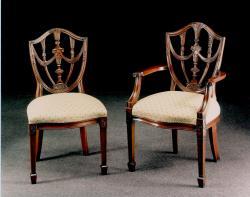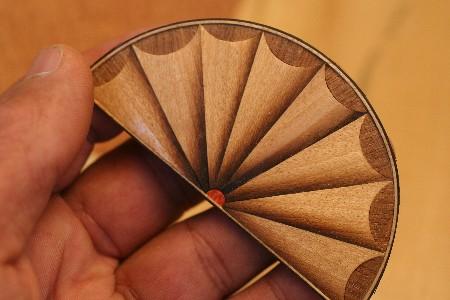Federal Style Furniture – Classic Lines and Rich Wood Tones
Media Gallery
History
Federal style furniture came into popularity in the United States after the Revolutionary War, during the so-called “Federal Period” from 1780 to 1820. The style has plenty in common with neoclassical furniture, which was popular during the same time period throughout Europe. Federalist furniture, however, has features not found anywhere else: patriotic touches like stars and eagles, for example, as well as highly specialized regional variations on the theme. Today, Federal style furniture remains exceptionally popular for its classic lines and rich wood tones. These pieces are equally at home in expansive libraries, opulent courthouses and modern apartments.
Wood
Federal style furniture was virtually always constructed of mahogany, with a few notable exceptions. In Connecticut, furniture was typically constructed from cherry, because the wood was plentiful there. On cheaper pieces throughout the new nation, walnut, dyed red with potassium chloride, was used. Accents and veneers were also created from other woods; satinwood and flame birch were popular options.
Characteristics
During the Federal Period, craftsmen departed from the heavy, ornate carvings popular during the Georgian period, preferring shallower reliefs and lighter construction techniques. Curves were replaced with straight lines and tapered legs. Elaborately carved feet disappeared; craftsmen preferred the clean look of a foot that extended as part of the leg.
Light blue was an exceptionally popular color during this time, and the interiors of case goods were often painted in this hue.
Several new types of furniture came into being during this era. Sideboards became popular, and specialized sewing tables also made an appearance for the first time. Practical sectional tables took up less space than the giant library tables of the past but offered seating for many guests if necessary. Dressers and chests also gained an important addition in many cases: a matching, attached mirror.
Federal style furniture can perhaps be described as the first real American style furniture. In the past, woodworkers had done their best to create replicas of European designs using local materials. During the Federal Period, however, artistic license took over and a huge range of specialized regional styles developed. Although the European influence remained visible, it was greatly diluted.
Connecticut
In Connecticut, furniture of all types was frequently characterized by elaborate inlays. Bellflowers, carrot-shaped designs, and a pattern resembling a ferris wheel were common.
Maryland
After the war, Baltimore became a hub for cabinetmakers in the United States, and Maryland craftsman were well-known for their elaborate painted pieces and their églomisé (glass panels decorated with allegorical figures). Bellflowers and oval inlays surrounded by mitered panels were also popular with designers.
New York and New Jersey
Cabinetmakers, including the famous Duncan Phyfe, settled throughout New York; New York City, in particular, became the epicenter for American fashion and furniture. One notable characteristic of New York furniture is the squared-off chair back with urn shaped splats. In New Jersey, craftsman often made several types of furniture in a single shop, creating the new styles as well as the traditional versions favored by many customers. The quarter-fan motif was popular throughout both New York and New Jersey.
Pennsylvania
Urns and carved drapery were common embellishments on Pennsylvania creations. Elaborate painting was common on chairs, chests, and dressers.
Rhode Island
Pieces made in Rhode Island, particularly card tables, often had distinctive geometric inlays. An unusual chair design, with a shield-shaped back, also developed here.
South Carolina
Wealthy plantation owners typically had their furniture shipped from New York, and local craftsmen mimicked these styles, so their construction is similar to pieces found further North. However, one unique feature developed on many South Carolinian designs: a motif inspired by the rice plant, which grew in profusion in the Charleston area.
Embellishments
Hardware was typically made of brass, although ormolu, a technique designed to mimic gold, was also fashionable. Popular motifs for relief carvings included urns, sheaves of wheat, rosettes, harps, cornucopias, thunderbolts, stars, eagles, acanthus leaves, bows, ears of corn, bellflowers, hearts, and military-inspired shields. Highly contrasting inlays of light and dark wood arranged in geometric patterns were also a defining feature of this era.
What to Look For
Sideboards, sewing tables, and chairs were the most frequently produced items during the Federal Period and remain the most commonly available antiques today. Reproductions of a variety of items are available at affordable prices, however, and even many modern furniture makers, including Ethan Allen, often rely on Federalist-type styling to create their new designs.
Price
For genuine antiques from the Federalist era, expect to pay around $200 for a chair and $600-$900 for a work table or desk. It’s worth noting that in the 1930s and 1940s, Federal-style furniture experienced a revival and thousands of excellent-quality reproductions were produced. These more modern versions cost approximately half of what similarly styled, older furniture would.
Images
Federal Style Sewing Table: Sewing tables, complete with a bag to collect fabric scraps, were a staple in almost every home during the Federal period. Federal Style Sewing Table Photo Courtesy Cowles Syndicates, Inc.
Federal Style Chair: Uniquely shaped chair backs, like this interpretation of a shield, are a hallmark of Federal Furniture. Photo courtesy Philip Hunt Antique Replicas.
Wood Fan Inlay: Highly contrasting inlays like this one were popular on Federal Style Furniture. Photo courtesy Philadelphia Furniture Workshop.




